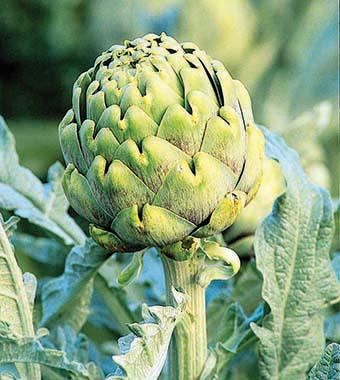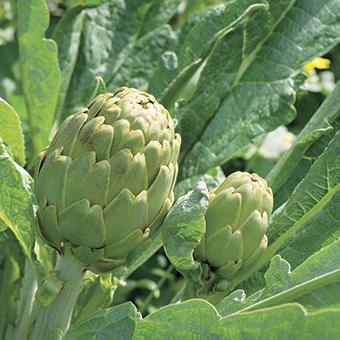
Artichokes Need Extra Tending, But Are Worth the Trouble
Artichokes (Cynara scolymus) are perennials, grown for their edible stalks and flower buds. They are believed to be native to the central Mediterranean area in Italy. Today, artichokes are mostly produced commercially in the mild, humid climates of California and Florida, but they can grow in many other zones. They need 100 frost-free days, a sunny, well-drained site and some winter protection in colder climates.
There are two main artichoke varieties: ‘Green Globe’ for warmer climates, and ‘Imperial Star,’ grown as an annual.The plants are large and resemble thistles, and produce for almost a decade. In warm areas, some afternoon shade should be provided, as high temperatures can stunt the buds and make them tough.
You can replant dormant root divisions, but seed-grown plants will mature earlier. Before sowing, it is recommended to refrigerate seeds in damp peat moss for two weeks to promote germination. (Actually, I skip this step with my own seeds and most germinate just fine). Plant seeds a half-inch deep in four-inch pots, six to eight weeks before the last frost. Place in a warm, south-facing window and keep the soil moist. A pH range of 6.5 to 7.5 is ideal. Once the seeds germinate, give them a taste of cool temperatures for a few weeks to make them feel as though they’ve gone through a winter. I put my plants in my garage.
The ultimate bed should contain lots of compost and aged manure. Place each plant about three feet apart in all directions. Also, protect against any late frost. As the weather warms, mulch to keep the soil moist. Salt hay or chopped and shredded hay and straw is best. Water frequently when temperatures exceed 75°. Feed weekly with fish fertilizer, as they are heavy feeders.
In Zones 7 and 8 the plants can overwinter in the ground. After the first killing frost, strip off any dead foliage and completely cover the plants with mulch, a cardboard box or a bushel basket with some soil to hold it in place. In spring, once the ground begins to thaw, uncover the plants completely to let the soil warm up.
In most areas, it is easier to treat globe artichokes as annuals. Dig up roots, brush off soil and cut the stems a few inches above the crown. Store roots in mesh bags in a cool, frost free location. Replant in the spring.
Keep an eye out for aphids, caterpillars and slugs, and treat as required. Harvest the buds when they are the size of a baseball before they open, with an inch or two of stem attached. Refrigerate if you can’t steam them immediately. They will last a couple of weeks. Try to leave some buds to mature in the garden and flower in the fall. They form a striking purple, thistle-like flower.
Here is a recipe that was my mother’s favorite:
Steam a bud for about 45 minutes in a pot with a lid until you can pull out a leaf easily and the “meat” slides off easily with your teeth. Drain the water and let it cool.
Very carefully, ease the leaves outward, opening the bud to expose the “choke” inside (the stringy covering over the heart). With a spoon, again, carefully scrape off all the stringy parts, exposing the heart. Gently close the leaves back in place.
Place each bud in a plastic, zip-lock bag and douse with any Italian dressing of your choice. (I use Newman’s Own Italian). Place in the refrigerator for three days so the leaves and heart become totally marinated.
Serve cold as you would a salad. No need for drawn butter, any sauce or dip. Enjoy.


